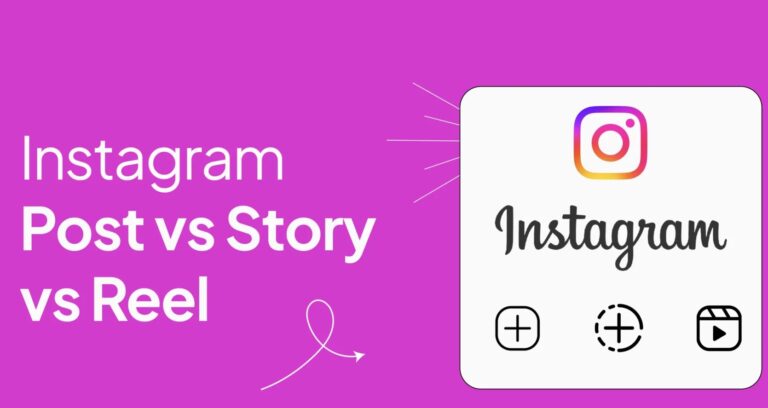Instagram has become a powerhouse for content creators, businesses, and influencers alike—but mastering its features means understanding when and how to use them strategically. Two of its most popular formats, Reels and Stories, offer unique ways to engage your audience, but they serve very different purposes. While Reels are built for reach and viral potential, Stories are ideal for fostering real-time, intimate connections with your current followers.
Also Read: 17 Standout Instagram Bio Ideas to Elevate Your Profile in 2025
Reels vs Stories on Instagram: Main Differences
Instagram Reels and Instagram Stories are two powerful content formats, but they serve different functions within the app. Reels are short-form videos meant for discovery, helping users reach a broader audience through the Reels tab and Explore page. These videos can include music, effects, and edits, making them ideal for tutorials, entertainment, and trending content.
Stories, in contrast, are designed for real-time engagement with your current followers. They last only 24 hours (unless saved to Highlights) and are perfect for sharing updates, behind-the-scenes moments, or interactive content like polls and questions. Understanding the core differences between Reels and Stories is essential for developing a strategic Instagram content plan.
Instagram Reels and Stories: Video Views Comparison
When comparing video views between Instagram Reels and Stories, the metrics often vary based on audience size, content quality, and timing. Reels usually generate more views over time because they are promoted by Instagram’s algorithm beyond your follower base. A well-performing Reel can go viral and attract new followers.
On the other hand, Instagram Stories receive fewer views but often result in higher engagement from your existing audience. Stories appear at the top of your followers’ feeds and are ideal for direct, personal interaction. If your goal is to increase visibility and grow your account, Reels are more effective; if you want to build trust and maintain connections, Stories are the better choice.
When to Post Instagram Reels vs Stories?
Posting Instagram Reels and Stories at the right time can significantly affect reach and engagement. Reels are best posted during peak activity hours—typically in the late afternoon or early evening—when your target audience is most active. Since Reels stay on your profile and in the discovery feed, they continue to gain traction for days or even weeks.
Instagram Stories, being temporary, are more effective when posted throughout the day to maintain audience attention. Morning, midday, and evening Story updates can help you stay visible in your followers’ feeds. Scheduling content strategically allows you to maximize both short-term and long-term engagement.
When to Post Instagram Stories vs Reels?
Deciding when to post Instagram Stories versus Reels depends on your content type and marketing goals. Use Stories for immediate updates, flash sales, announcements, and behind-the-scenes glimpses that benefit from real-time visibility. These are best posted when you are actively engaging with your audience during the day.
Reels, which require more editing and polish, should be reserved for high-impact content that you want to circulate widely—such as product showcases, educational content, or viral challenges. If you’re launching a campaign, consider publishing a Reel first to draw attention, then follow up with Stories to provide additional context and interaction.
How to Combine Reels and Stories
Using Instagram Reels and Stories together in a coordinated strategy can significantly boost your content performance. Start by publishing a Reel to attract new followers and increase discoverability. Then, repurpose snippets of that Reel in your Stories to remind existing followers to check it out. You can also use Stories to provide a behind-the-scenes look at how the Reel was made or invite feedback through polls or questions.
Cross-promoting Reels and Stories increases retention, encourages deeper engagement, and reinforces your messaging across multiple touchpoints. This content synergy helps you build a stronger presence on Instagram.
Frequently Asked Questions
Should I post the same content on both Reels and Stories?
It’s better to tailor content to each format. While you can repurpose content, Reels work best with polished, shareable videos, whereas Stories are more effective when they’re raw, spontaneous, and interactive.
Do Instagram Reels get more engagement than Stories?
Reels often generate more reach and views due to algorithmic promotion, but Stories typically have higher engagement from your existing followers thanks to interactive features like polls, stickers, and replies.
Can I share a Reel to my Story?
Yes, and it’s a great way to boost your Reel’s visibility. Just remember, viewers need to tap through to watch the full Reel, so use an eye-catching preview and a strong call-to-action in the Story.
How many Reels or Stories should I post in a day?
There’s no one-size-fits-all rule, but generally, posting 1–2 Reels per week and several Stories per day can keep your profile active without overwhelming your audience.
Which is better for business promotion—Reels or Stories?
Both have value. Use Reels to attract new customers through discovery, and Stories to keep current followers engaged with updates, behind-the-scenes looks, and promotions.
Conclusion
Ultimately, Reels and Stories are not competing tools—they’re complementary. Reels help you get discovered; Stories help you build trust and connection. By understanding the strengths of each format and planning your content accordingly, you can expand your reach while deepening engagement. Whether you’re a content creator looking to grow your audience or a brand building loyalty, combining Reels and Stories with intention will give you a powerful edge in Instagram marketing.

